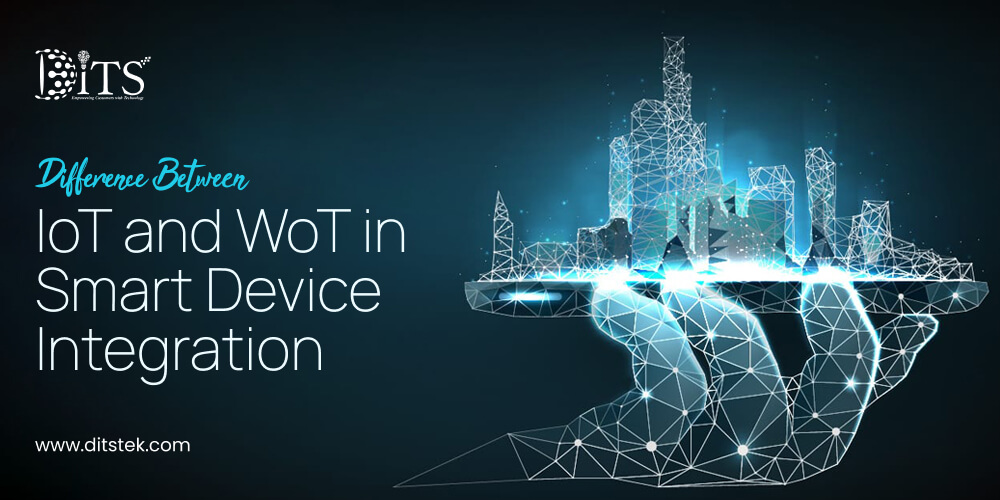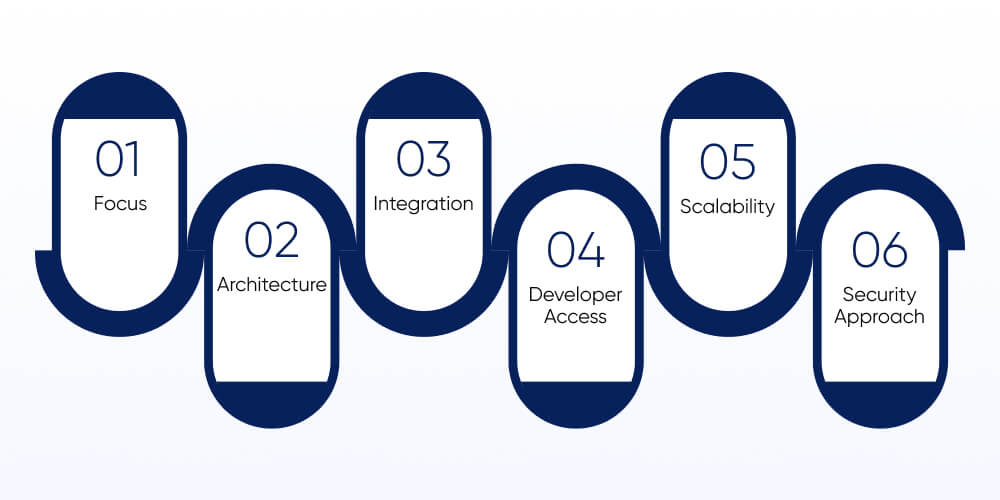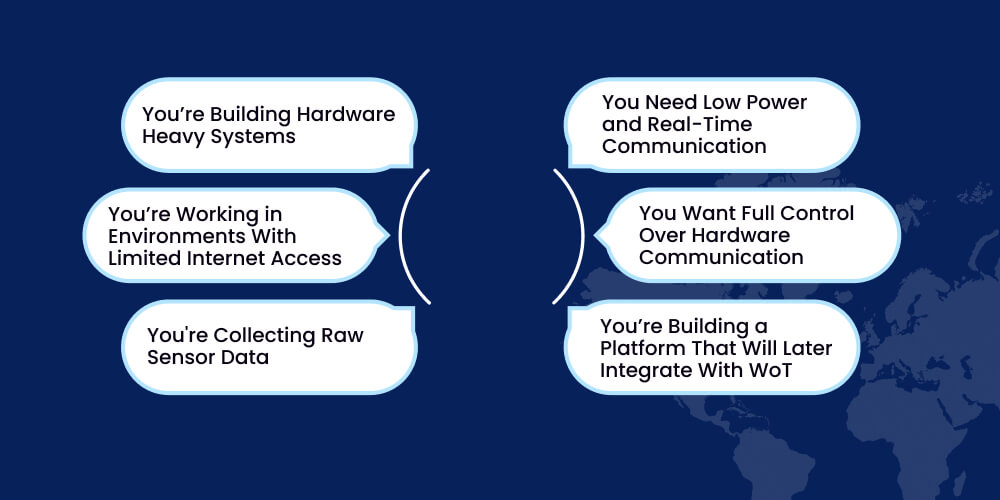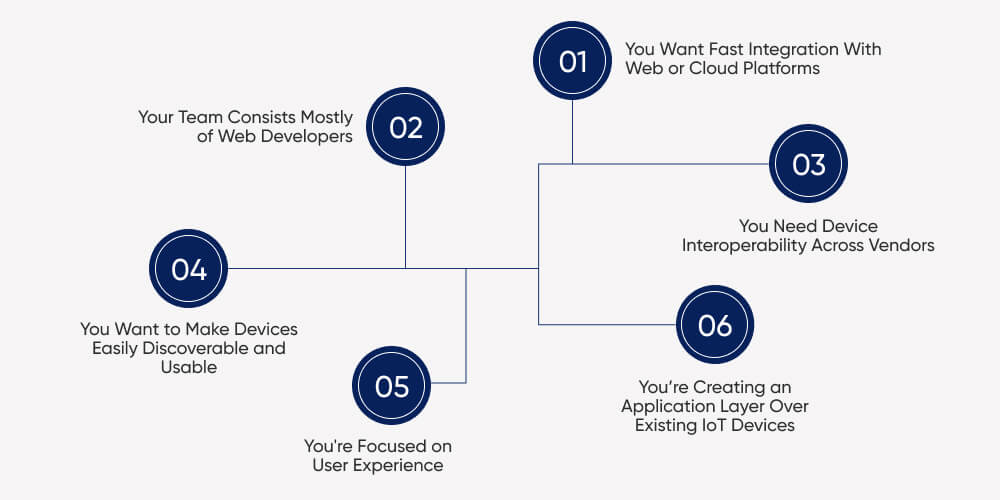Difference Between IoT and WoT in Smart Device Integration
Ditstek Blogs
Smart devices are everywhere; inside our homes, offices, factories, and even cars. From voice assistants to security cameras and smart lights, these devices connect to the internet and work together to make our lives easier. This growing network of connected devices is known as the Internet of Things (IoT).
But there’s another term you may have heard of: the Web of Things (WoT). While it sounds similar to IoT, it’s actually quite different in how it helps devices connect and communicate; especially when it comes to working with other systems or platforms.
In this blog, we’ll explain what IoT and WoT really mean, how they work in smart device integration, and most importantly, the difference between IoT and WoT. Whether you’re a tech enthusiast, business owner, or just curious about smart technology, this guide will help you understand the key differences between IoT and WoT in simple terms.
Is Your Smart Device Strategy Future-Ready?
Most businesses connect devices but struggle with integration. With expert guidance, you can unlock efficiency, scalability, and growth. Don’t just connect—control.
What Is IoT (Internet of Things)?
The Internet of Things (IoT) is a term used to describe physical devices—like smartwatches, thermostats, or even factory machines - that are connected to the internet and can collect or share data. These devices often have sensors, software, and internet connectivity that allow them to “talk” to each other and take actions without human intervention.
How IoT Works
IoT works by linking devices to a network. For example:
- A smart home security camera sends video to your phone
- A smart thermostat adjusts the temperature based on your habits.
- A wearable fitness tracker records your steps and sleep patterns.
Behind the scenes, these devices gather data and send it to cloud systems or apps, where the information can be analyzed and used to make decisions.
Why It Matters for Smart Device Integration
IoT helps devices work together in real-time. However, because different manufacturers use different technologies and protocols, integrating these devices into one system can be tricky. This is where specialized solutions like Custom IoT Software Development Services come in; they help businesses build tailored systems that connect and control various devices smoothly.
When we talk about the difference between IoT and WoT, IoT focuses more on the hardware and network-level communication, while WoT emphasizes making those devices easier to use and access through standard web technologies.
What Is WoT (Web of Things)?
The Web of Things (WoT) is built on top of IoT. It takes the smart devices connected through IoT and makes them easier to access and control—using standard web technologies like HTTP, URLs, and JSON. In simple words, while IoT connects the devices, WoT connects them to the web in a more user-friendly and developer-friendly way.
How WoT Works
WoT uses web principles to describe, access, and control devices. For example:
- Instead of using a special app, you can control a smart device using a web browser
- Devices can be discovered, described, and interacted with using RESTful APIs
- WoT enables different devices to communicate with each other, regardless of their brand.
This approach makes integration easier, especially when devices are from different manufacturers or need to work with cloud platforms.
WoT’s Role in Smart Device Integration
When companies want all their devices to work together smoothly, WoT makes that integration simpler. It’s particularly useful in large setups like smart buildings or factories, where many different types of devices are used together.
For instance, in the top applications of IoT across industries, such as smart energy grids or connected agriculture, WoT can streamline how devices communicate through standardized web layers.
Now, when we look at the difference between IoT and WoT, we can say:
- IoT connects the things (devices)
- WoT connects those things to the web using a common language.
This makes WoT essential for creating scalable, flexible, and web-compatible innovative solutions.
Want Devices to Speak a Common Language?
IoT builds connections, WoT builds clarity. Together, they make integration smooth, scalable, and web-ready. Let’s design systems that work beyond brand limitations.
Core Difference Between IoT and WoT in Smart Device Integration
When it comes to connecting and managing smart devices, especially in commercial settings, both IoT and WoT play essential roles, but in different ways.
IoT focuses more on connecting physical devices through networks and enabling data flow between them. It deals with the sensors, hardware, and communication protocols needed to make devices “smart.”
WoT on the other hand, helps those smart devices interact easily using standard web tools like browsers and APIs. It enables developers to create user-friendly systems that communicate with multiple devices over the internet.
Let’s take the example of IoT in healthcare. Hospitals use IoT devices like heart-rate monitors, infusion pumps, and wearable health trackers. These devices gather patient data and transmit it in real-time.
But with WoT, that same data can be accessed using web dashboards or mobile apps, shared across departments, or even integrated into telemedicine platforms, making the data more usable and accessible.
This is the primary difference between IoT and WoT. IoT handles how the data is collected, while WoT focuses on how that data is shared and used.
Comparison Table: IoT vs WoT
| Aspect | IoT (Internet of Things) | WoT (Web of Things) |
| Focus | Connecting physical devices and enabling communication | Making devices accessible via web technologies |
| Architecture | Sensor-based networks, gateways, device protocols | Web APIs, RESTful interfaces, Things Description (TD) |
| Integration | Often vendor-specific, uses custom protocols | Web-friendly, platform-independent integration |
| Developer Access | Requires knowledge of hardware and protocols | Uses common web tools (HTML, JS, HTTP, JSON) |
| Scalability | Complex at scale due to protocol differences | Easier to scale with standardized web components |
| Example Use | Sensor in a hospital sending patient vitals | Dashboard showing patient data in real-time from multiple devices |
| Security Approach | Device-level security, firmware controls | Uses standard web security (OAuth2, HTTPS, CORS) |
| Main Advantage | Efficient at device communication and data collection | High interoperability and ease of integration |
Explaining the Key Differences Between IoT and WoT

The comparison table above shows how IoT and WoT approach smart device integration differently. Let’s go through each point to help understand them better.
Focus
- IoT is mainly about connecting physical devices, like sensors, machines, or appliances, to the internet so they can collect and share data.
- WoT is focused on making those devices easier to access and control using web technologies. It brings the web into the world of smart devices.
Architecture
- In IoT, devices use layers like sensors, gateways, and communication protocols (e.g., MQTT or Zigbee) to send and receive data.
- In WoT, the structure is based on the web, using APIs, URLs, and things descriptions (which describe how to interact with each device via the web).
Integration
- IoT often relies on vendor-specific tools or hardware, which can make it hard to combine devices from different brands.
- WoT uses standard web technologies, so it’s easier to mix and match different devices and make them work together.
Developer Access
- Working with IoT usually means understanding hardware, low-level code, and device protocols.
- With WoT, web developers can easily build smart applications using tools they already know, like HTML, JavaScript, and REST APIs.
This is a key difference between IoT and WoT—WoT lowers the barrier for software teams, making smart devices accessible without deep hardware knowledge.
Scalability
- As the number of IoT devices grows, managing different protocols and systems can get very complex.
- WoT, by using web standards, makes it easier to scale up and manage large numbers of devices across platforms.
Example Use
- In IoT: A hospital sensor can track a patient’s vital signs and send that data to a server.
- In WoT: A web dashboard can be used by doctors to see and analyze that same data in real time, pulled from multiple devices.
Security Approach
- IoT depends on built-in device security like firmware updates or secure chips.
- WoT uses common web security methods, such as HTTPS, OAuth2, and access control rules, making it easier to manage at scale.
This is especially important for businesses partnering with an AI Software Development Company, where secure data flow between smart devices and AI tools is essential.
Main Advantage
- IoT is great at building the infrastructure of connected devices.
- WoT is best when you want those devices to work together smoothly across the web, using standard tools.
Struggling With Device Compatibility Issues?
Different vendors, different platforms, endless complexity. WoT makes interoperability simple. Discover how your devices can talk fluently and work smarter with custom integration.
When to Use IoT vs WoT in Smart Device Integration
Knowing when to use IoT and when to use WoT can help businesses and developers choose the right technology stack for their smart systems. Both have their strengths, and often, they work best when used together. Below are some scenarios to help you decide which approach fits your needs best.
And yes, we’ll continue to highlight the difference between IoT and WoT in practical use.
When IoT Is the Better Choice

- You’re Building Hardware-Heavy Systems
If your project involves direct control of sensors, motors, or machines, especially in manufacturing or robotics, IoT is the base layer that handles real-time device communication. - You Need Low Power and Real-Time Communication
IoT protocols like ZigBee or MQTT are designed to be light and fast—ideal for battery-operated or real-time systems. - You’re Working in Environments With Limited Internet Access
IoT works well in remote areas using gateways and edge devices that can operate offline or sync later. - You Want Full Control Over Hardware Communication
Custom IoT architectures let you design everything from the device firmware to the network flow, giving you deep control. - You're Collecting Raw Sensor Data
For systems where large volumes of raw data (like temperature, humidity, or motion) are collected and stored, IoT protocols are optimized for this. - You’re Building a Platform That Will Later Integrate With WoT
IoT serves as a strong foundation layer, which can later be exposed to web interfaces using WoT principles.
When WoT Is the Better Choice

- You Want Fast Integration With Web or Cloud Platforms
WoT uses standard web APIs, so integrating with cloud systems, mobile apps, or dashboards is easier and faster. - Your Team Consists Mostly of Web Developers
If your team is more experienced with JavaScript, HTTP, and REST APIs, WoT will feel natural and require less training. - You Need Device Interoperability Across Vendors
WoT abstracts the technical differences between devices, letting you unify control using common web structures. - You Want to Make Devices Easily Discoverable and Usable
With Things Description (TD), devices can be discovered and interacted with over the web like regular web pages. - You're Focused on User Experience
WoT makes it easier to build user-friendly dashboards and apps that can interact with multiple devices at once. - You’re Creating an Application Layer Over Existing IoT Devices
If you already have IoT hardware in place, WoT allows you to create a web-based system to manage and use it effectively.
Real-World Example
A company managing smart offices might use IoT to collect real-time data from devices like thermostats, lights, and occupancy sensors. But to control these devices via a mobile app or a browser dashboard, they may apply WoT to build a web interface on top. This hybrid model brings the best of both worlds.
So, while the difference between IoT and WoT may seem technical at first, it directly impacts how smart systems are built, managed, and experienced by users.
Want to Future-Proof Your Smart Ecosystem?
Technology evolves fast. Businesses that align IoT with WoT stay relevant, scalable, and user-friendly. Don’t let outdated systems hold you back.
How DITS Can Help with IoT Software Development and Integration
At Ditstek Innovations (DITS), we specialize in building custom IoT solutions that go beyond just connecting devices. We focus on delivering end-to-end IoT software development and integration services to help businesses unlock real value from their smart systems.
Whether you're planning to launch a new IoT-enabled product or want to streamline operations with smarter device networks, our team ensures that your systems are scalable, secure, and easy to manage.
We design and develop software tailored to your industry and business needs, covering everything from embedded systems and firmware to cloud-based dashboards and analytics platforms.
Our team helps you integrate various devices, sensors, and gateways into one unified system, regardless of the brand or communication protocol.
We build user-friendly web and mobile apps that interact with your IoT devices using standard web technologies, making your systems more accessible, even across departments or external platforms.
Our solutions power businesses across healthcare, logistics, agriculture, energy, and more. Whether it’s remote patient monitoring or smart iot fleet management, we bring deep domain experience.
At DITS, we don’t just help you adopt IoT, but build an innovative, connected ecosystem tailored for long-term success. Reach out to our team to explore how we can help you design, develop, and deploy a future-ready IoT solution.
Conclusion
Smart device integration has become a key part of how homes, hospitals, factories, and cities operate today. Both IoT (Internet of Things) and WoT (Web of Things) play essential roles in making this possible, but in different ways.
While IoT connects devices and enables communication, WoT takes it a step further by making these devices easy to access and control through web technologies. Understanding the difference between IoT and WoT helps businesses build systems that are both powerful and easy to manage.
With the help of an experienced IoT Software Development Company, businesses can create future-ready solutions tailored to their unique needs.
FAQs
1. What is the main difference between IoT and WoT?
IoT focuses on connecting physical devices and enabling communication between them. WoT uses web technologies to make those devices easier to control, access, and integrate.
2. Can IoT and WoT work together in one system?
Yes. IoT builds the core device communication layer, and WoT adds a web-based layer on top, making the system more flexible and user-friendly.
3. Why is WoT useful for businesses?
WoT helps businesses integrate devices from different vendors, create centralized dashboards, and offer better user experiences through web-based control systems.
4. Is WoT replacing IoT?
No. WoT is not a replacement but an extension of IoT. It enhances IoT systems by adding web compatibility and simplifying integration.
5. How can IoT development help my business grow?
IoT solutions can automate processes, improve operational efficiency, reduce costs, and provide real-time insights from connected devices—helping you make data-driven business decisions faster.
6. Can you integrate IoT solutions into my existing business software?
Yes. We design IoT and WoT solutions that integrate seamlessly with your current ERP, CRM, or custom business platforms—ensuring smooth workflows and minimal disruption.
7. What is the cost of IoT or WoT development for businesses?
Costs vary based on features, hardware, integrations, and scalability. We offer flexible engagement models so you can start small and scale your investment as results grow.
8. Can IoT and WoT work with my existing hardware devices?
In most cases, yes. Our team assesses your current devices for compatibility and either adapts them for IoT/WoT integration or suggests suitable hardware upgrades.

Dinesh Thakur
21+ years of IT software development experience in different domains like Business Automation, Healthcare, Retail, Workflow automation, Transportation and logistics, Compliance, Risk Mitigation, POS, etc. Hands-on experience in dealing with overseas clients and providing them with an apt solution to their business needs.
Recent Posts
Get in touch











 Marriott Downtown Hotel | Calgary
Marriott Downtown Hotel | Calgary Calgary | Edmonton | Vancouver | Toronto
Calgary | Edmonton | Vancouver | Toronto